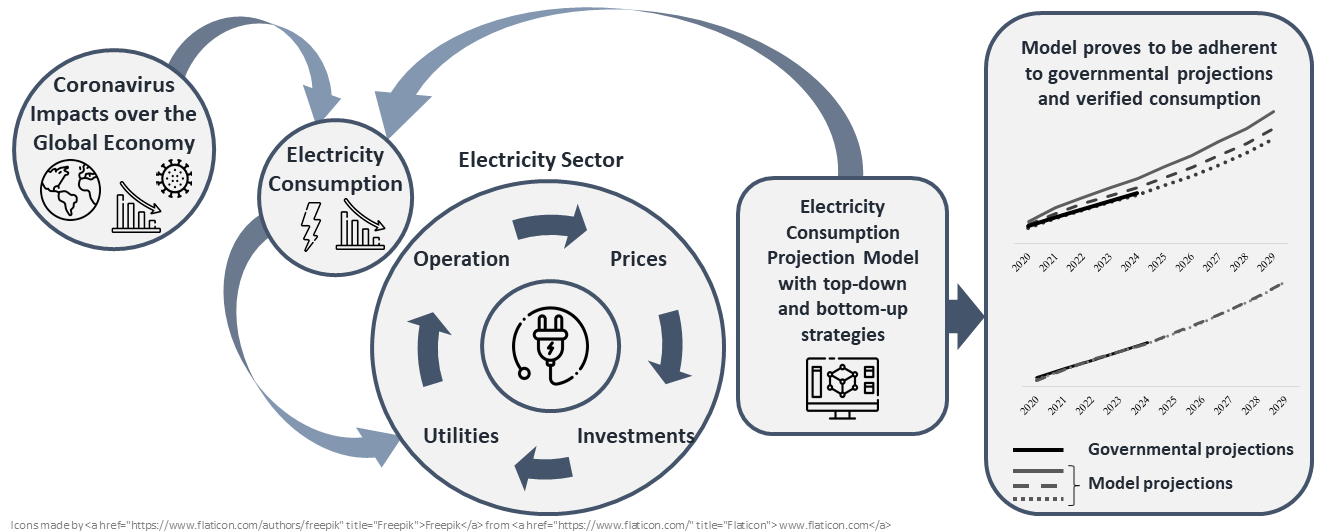The impact of COVID-19 on the Brazilian Power Sector: operational, commercial, and regulatory aspects
Keywords:
Demand Forecasting, Electricity Sector, Regulation, Power DemandAbstract
The Coronavirus outbreak has imposed different levels of stay-at-home orders worldwide to help contain the disease spread, thus promoting severe impacts over the global economy. The World Bank expects 90% of the world economy to go into recession, being this the most severe global economic crisis since the second world war. Consequently, electricity consumption has fallen sharply in many countries, so as in Brazil, what provoked critical effects over many electricity sector stakeholders. In this context, this article discusses the main consequences of COVID-19’s outbreak over the Brazilian electricity sector and some measures taken by the government and the regulator to address such issues. Further, this work proposes a long-term electricity demand forecast methodology, taking into consideration bottom-up technics for general demand growth and top-down technics for the expansion of distributed generation in Brazil. The model uses as input economic forecasts from the World Bank, the International Monetary Fund and Brazilian market consolidated expectations disclosed by the Brazilian Central Bank. The model proves to be useful to long-term demand forecast by producing results adherent to official forecasts published by Brazilian governmental institutions.
Downloads
References
H. K. Jacobsen, “Integrating the bottom-up and top-down approach to energy economy modeling: the case of Denmark,” Energy Economics, vol. 20, pp. 443 - 461, 1998.
EPE, “Nota Técnica DEA 15/09 - Projeção da Demanda de Energia Elétrica para os Próximos 10 anos,” Empresa de Pesquisa Energética, Rio de Janeiro, 2009.
EPE, “Plano Decenal de Expansão 2029,” Empresa de Pesquisa Energética, Rio de Janeiro, 2019.
E. M. Rogers, “Diffusion of Innovations,” 5th ed., Simon and Schuster, 2003.
WHO, “WHO Timeline - COVID-19,” World Health Organization, Accessed on: Apr. 27, 2020, [Online]. Available: https://www.who.int/news-room/detail/27-04-2020-who-timeline---covid-19.
C. Kang et al., “Implementation of quarantine in China during the outbreak of COVID-19,” Elsevier Public Health Emergency Collection. Apr. 2020, DOI: 10.1016/j.psychres.2020.113038.
WBG, “Global Economic Prospects - June 2020,” World Bank Group, Washington, 2020.
IMF, “World Economic Outlook Update - June 2020,” InternationalMonetary Fund, 2020.
IBGE, “Produto Interno Bruto – PIB,” Instituto Brasileiro de Geografia e Estatística, Accessed on: Sep. 1, 2020, [Online]. Available: https://www.ibge.gov.br/explica/pib.php
IMF, “Policy Responses to COVID-19,” International Monetary Fund, Accessed on: Nov. 19, 2020, [Online]. Available: https://www.imf.org/en/Topics/imf-and-covid19/Policy-Responses-toCOVID-19#U.
IEA, “Covid-19 impact on electricity,” International Electricity Agency, Accessed on: Nov. 19, 2020, [Online]. Available: https://www.iea.org/reports/covid-19-impact-on-electricity#impact-oflockdown-measures.
N. J. de Castro, “Informativo Eletrônico do Setor Elétrico: nº 5.089 - 25 de agosto de 2020,” Grupo de Estudos do Setor Elétrico, Rio de Janeiro, RJ, Brasil, ISSN 1678-6130, Aug. 2020.
ONS, “Plano de Operação Energética 2020 - Sumário Executivo,” Operador Nacional do Sistema, Rio de Janeiro, 2020.
EPE, “Estudos do Plano Decenal de Expansão de Energia 2030 - Avaliação do Suprimento de Potência no Sistema Elétrico e impactos da Covid-19,” Empresa de Pesquisa Energética, Rio de Janeiro, 2020.
Ministério da Economia, “Boletim Informativo de Debêntures Incentivadas - Julho de 2020,” Ministério da Economia, Brasília, 2020.
J. Coelho, “Opinião Legal: Impactos das medidas associadas ao controle do COVID-19 sobre os contratos de comercialização de energia elétrica,” Julião Coelho, 2020.
EPE, “Balanço Energético Nacional - Séries Históricas Completas,” Empresa de Pesquisa Energética, Accessed on: Sep. 4 2020. [Online]. Available: https://www.epe.gov.br
IBGE, “Séries Históricas e Estatísticas - IBGE,” Instituto Brasileiro de Geografia e Estatística, Accessed on: Sep.4, 2020. [Online]. Available: https://seriesestatisticas.ibge.gov.br/lista_tema.aspx?op=0&no=10.
F. M. Bass, “A New Product Growth for Model Consumer Durables,” Management Science, vol 15, no. 5, pp. 215-227, Jan., 1969.
B. Sigrin, M. Gleason, R. Preus, I. Baring-Gould and R. Margolis, “The Distributed Generation Market Demand Model (dGen)” National Renewable Energy Laboratory, 2016.
AEMO, “National Electricity Forecasting Report for The National Electricity Market (NEM),” Australian Energy Market Operator, 2012.
J. C. Kastovich, R. R. Lawrence, R. R. Hoffman and C. Pavlak, “Advanced electric-heat-pump market and business analysis. Final report,” Westinghouse Electric Corp., Pittsburgh, PA (USA). Research and Development Center, USA, 1982.
Navigant Consulting, “Arizona Solar Electric Roadmap Study - Full Report,” Arizona Department of Commerce, Burlington, 2007.
R. W. Beck, “Distributed Renewable Energy Operating Impacts and Valuation Study,” Arizona Public Service, 2009
M. Guidolin and C. Mortarino, “Cross-country diffusion of photovoltaic systems: Modelling choices and forecasts for national adoption patterns,” Technological Forecasting and Social Change, vol. 77, no. 2, pp. 279-296, Feb., 2010. DOI: https://doi.org/10.1016/j.techfore.2009.07.003.
T. Islam, “Household-level innovation diffusion model of photo-voltaic (PV) solar cells from stated preference data,” Energy Policy, vol. 65, pp. 340-350, Feb., 2014. DOI: 10.1016/j.enpol.2013.10.004


